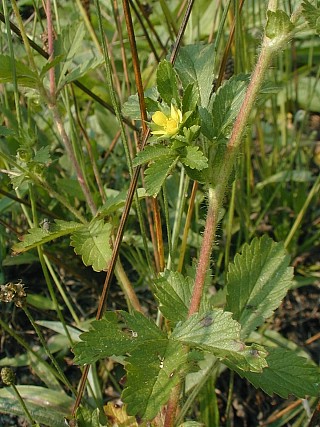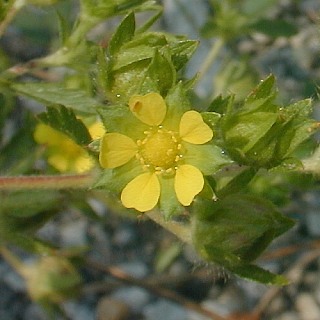Description: This
plant is an annual, biennial, or short-lived perennial. It
initially consists of a rosette of basal leaves about 6" across, later
developing flowering stalks about 1-2' long. The basal leaves are
trifoliate with long hairy petioles. Each leaflet is obovate or oval,
coarsely serrated, and slightly hairy across the upper surface; it is
typically about 2" long and 1" across. The flowering stalks have long
spreading hairs and alternate trifoliate leaves. They are often reddish
green in appearance and semi-erect or spreading. The lower to middle
alternate leaves are similar in appearance to the basal leaves, except
that they are slightly smaller and have shorter petioles. The upper
leaves are often simple and sessile, resembling narrow leaflets of the
lower leaves. Individual flowers may develop from the axils of these
upper leaves on short pedicels, although most of the flowers occur in a
terminal inflorescence consisting of a panicle of cymes. This
inflorescence has leafy bracts and its hairy stems have a tendency to
zigzag between the cymes of flowers. Each flower is about ½" across,
consisting of 5 yellow petals that are obcordate, 5 green sepals that
are triangular and spreading, 10-20 stamens with yellow anthers, and a
dome-shaped receptacle that is also yellow. The sepals are slightly
longer than the petals and clearly visible from above. Under each
flower, there are 5 green bracts that are spreading and
ovate-triangular. They are initially shorter than the sepals, but
become about the same length when the flower blooms. The blooming
period occurs during the summer and lasts about 1-2 months; the flowers
bloom sporadically during this period. The seeds are somewhat
flattened, asymmetrically reniform, and dark brown. The root system
consists of a shallow branching taproot. This plant spreads by
reseeding itself.
semi-erect or spreading. The lower to middle
alternate leaves are similar in appearance to the basal leaves, except
that they are slightly smaller and have shorter petioles. The upper
leaves are often simple and sessile, resembling narrow leaflets of the
lower leaves. Individual flowers may develop from the axils of these
upper leaves on short pedicels, although most of the flowers occur in a
terminal inflorescence consisting of a panicle of cymes. This
inflorescence has leafy bracts and its hairy stems have a tendency to
zigzag between the cymes of flowers. Each flower is about ½" across,
consisting of 5 yellow petals that are obcordate, 5 green sepals that
are triangular and spreading, 10-20 stamens with yellow anthers, and a
dome-shaped receptacle that is also yellow. The sepals are slightly
longer than the petals and clearly visible from above. Under each
flower, there are 5 green bracts that are spreading and
ovate-triangular. They are initially shorter than the sepals, but
become about the same length when the flower blooms. The blooming
period occurs during the summer and lasts about 1-2 months; the flowers
bloom sporadically during this period. The seeds are somewhat
flattened, asymmetrically reniform, and dark brown. The root system
consists of a shallow branching taproot. This plant spreads by
reseeding itself.
Cultivation:
This is an adaptable plant that can be found in full or partial sun,
moist to dry-mesic conditions, and fertile to sterile soil,
including loam, clay-loam, sandy loam, and stony soil. The foliage is
initially
attractive, but it has a tendency to become worn-out looking in dry
areas by the time the flowers bloom.
Range & Habitat:
Rough Cinquefoil is a common plant in northern and central Illinois,
but it is less common or absent in many areas of southern Illinois (see
Distribution
Map). Mohlenbrock (2002) considers this species to be
adventive from Eurasia, but other authorities think native strains
exist that are difficult or impossible to distinguish from those of the
Old World. I am inclined toward the former view because this species is
typically found in areas
that are weedy and disturbed. Habitats include weedy meadows, fields
and pastures, gardens and edges of yards, edges of parking lots, vacant
lots, borders of small streams, sloughs, sandy marshes, and
miscellaneous waste areas.
Faunal Associations:
The nectar and pollen of the flowers attract small bees and flies
primarily. Rabbits, groundhogs, deer, and livestock occasionally eat
the
foliage of Potentilla spp. (cinquefoils). The seeds
of cinquefoils are able to pass through their digestive tracts and
remain
viable, thus these mammalian herbivores play an important role in
their dispersion to new areas.

Photographic Location:
Near the edge of an abandoned parking lot at Judge Webber Park in
Urbana, Illinois. This plant was growing in stony ground.
Comments:
This is a rather coarse and weedy plant. During an early stage of its
development, Rough Cinquefoil resembles Fragaria virginica
(Wild Strawberry), but it later develops leafy flowering stalks with
yellow flowers that fail to produce any fleshy fruits. Rough Cinquefoil
differs from Potentilla simplex (Common Cinquefoil)
by its trifoliate leaves and terminal inflorescence; the latter has
palmate leaves with 5-7 leaflets and only axillary flowers. It also
resembles Potentilla millegrana (Diffuse
Cinquefoil) as both species have a similar growth habit and trifoliate
leaves. However, Diffuse Cinquefoil has stems that are softly pubescent
and smaller flowers (about ¼" across), while the stems of Rough
Cinquefoil have coarse spreading hairs. Diffuse Cinquefoil is uncommon
in Illinois and unlikely to be encountered; it is more common further
to
the west.